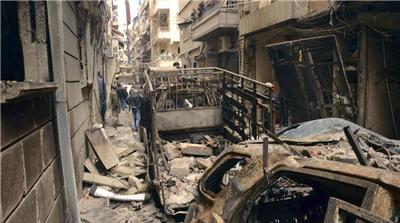
Armenia Supports Its Diaspora Community in War-Torn Syria
By:

In early October, Armenia sent two planes of humanitarian aid to Syria, which is suffering a new stage of escalation in its more-than-five-year-long crisis. Under the immediate instruction of Armenian President Serzh Sargsyan, nearly 40 tons of goods were transported to Khmeimim airbase, near Latakia (Asbarez, October 8). Moreover, on October 6, the Armenian government decided to send nearly $100,000 to the Syrian population via the Hayastan All Armenian Fund. According to data collected by the Armenian Ministry of Diaspora, between 40,000 and 45,000 members of the Armenian diaspora reside in Syria; and so the government in Yerevan believes state support to this war-torn country is crucially important. Though this was not the first time the Republic of Armenia has assisted its compatriots in Syria, the recent humanitarian relief campaign comes at a critically important period as the city of Aleppo—which features a particularly large Armenian community—faces an especially aggravated situation. It is worth noting that the Syrian government provided Armenia with humanitarian assistance in the early 1990s, when the collapse of the Soviet Union precipitated a severe crisis. Furthermore, the humanitarian aid sent to Syria by the Armenian government can be regarded as another demonstration of close interstate relations with Syria, which plays a key role (along with some other states) in Yerevan’s Middle Eastern policy.
The Armenian government has long paid close attention to developments in the Syrian crisis. Reportedly, 20,000 Syrian Armenians moved to Armenia for temporary or permanent residence since the start of the Syrian civil war in 2011. Consequently, Armenia is considered the third largest European recipient of Syrian refugees on a per capita basis (News.am, March 30). United Nations Secretary General Ban Ki-moon and United States President Barack Obama have both praised Armenia for its contribution to resolving the refugee crisis in Syria (Un.org, September 29, 2015; Armenpress, September 21, 2016). Armenia’s recently sent humanitarian assistance was also welcomed by the secretary general of the Collective Security Treaty Organization (CSTO), Nikolay Bordyuzha.
The Ministry of Foreign Affairs of Armenia has periodically condemned the targeting of civilian objects and atrocities against the civilian population. Back in 2014, Foreign Minister Edward Nalbandian issued a letter to Ban Ki-moon expressing his concerns about the clashes over the town of Kessab and 12 adjacent villages with a predominantly Armenian population. Moreover, the Armenian diplomat urged Turkey “to take immediate measures to prevent the further use of its territory by extremist groups” (Mfa.am, March 28, 2014).
The escalation of the civil war in areas with large Armenian populations has led to dozens of deaths and significant material damage to those communities. On June 5, Armenian foreign ministry spokesperson Tigran Balayan condemned the bombardment of the Armenian-populated quarters of Aleppo, which resulted in the death of four Armenians and serious damage to a number of schools, cultural centers and other civilian buildings (Mfa.am, June 5).
Assistance to the Syrian Armenians is also being offered by international Armenian diaspora organizations. Since 2012, the Armenian General Benevolent Union (AGBU) has raised nearly $2.5 million and still continues to support relief programs. In 2015, the Armenian National Committee of America (ANCA) urged the United States Congress to allocate financial aid to address the humanitarian crisis that has befallen Syrian Armenians (The Armenian Weekly, June 24, 2015).
For as long as the civil war rages on in Syria, the security of Syrian Armenians and the preservation of the property of the Armenian community will remain an urgent issue for Yerevan’s foreign policy agenda. And this challenge will also be a matter of concern for Armenian diaspora organizations worldwide. The humanitarian relief campaign in Syria serves as a clear demonstration of the Armenian government’s active engagement in diaspora affairs. Yerevan regularly emphasizes the importance of the Armenian state’s ties with its diaspora. And the embattled Syrian-Armenians represent the largest community of ethnic Armenians in the Middle East. Thus, despite the prevalence of domestic problems (see EDM, October 14, 2015; November 4, 2015; January 28, 2016), Yerevan’s active support for Armenians suffering abroad indicates how important this issue is to the Armenian government.



